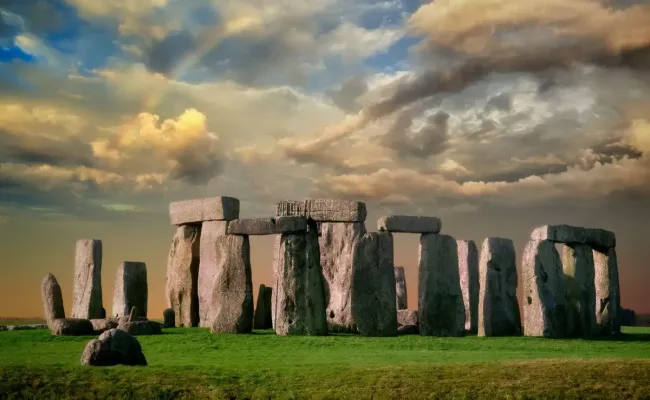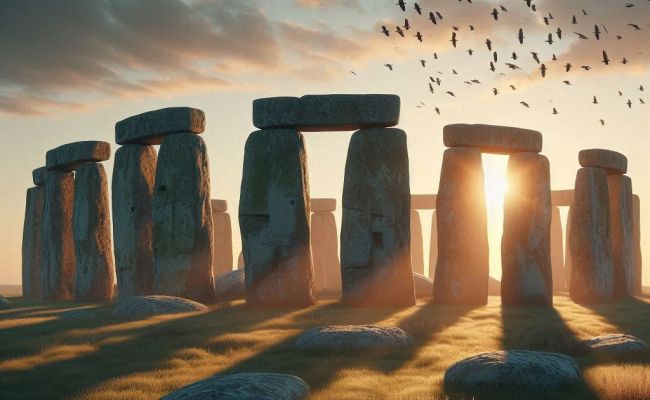Stonehenge, a prehistoric monument in Wiltshire, England, consists of enormous standing stones arranged in a circle. Although its specific purpose remains unknown, its construction almost 4,000 years ago is believed to have fulfilled ceremonial, religious, or astronomical services. Stonehenge continues to enchant visitors with its historic appeal and is a UNESCO World Heritage Site, symbolizing human ingenuity and spiritual discovery throughout history.
Constructing Stonehenge
Stonehenge was constructed in three stages. The majority of the construction took place between 2640 and 2480 BC.
The first stage began circa 3100 BC. During this stage, workers dug a circular ditch and a ring of 56 pits known as Aubrey Holes. The second stage began circa 2100 BC. During this stage, the Stonehenge builders imported massive rock pillars from Southwestern Wales and arranged them in concentric circles around the site’s center.
The third phase of construction saw the demolishment of this double circle, which remained incomplete. The final stage likely concluded before 1500 BC. The monument underwent renovations during this period. Its builders constructed a circle of 30 upright stones, each weighing up to 50 tons, topped with a ring of stone lintels. These surrounded a horseshoe-shaped construction of five pairs of upright stones, each topped with a stone lintel.
Using DNA research, experts revealed that the Stonehenge builders originated in what is now Turkey.

History
Stonehenge’s construction required two types of stones: bluestones and sarsen stones, each with their own origins and modes of transportation. The bluestones, which were mostly constructed of dolerite, were originally arranged in a circle of up to 80 stones, but only 43 remain now. These stones are thought to have been hauled around 160 miles from the Preseli Hills in Wales to Stonehenge, with the discovery of a quarry at Craig Rhos-y-Felin in Pembrokeshire in 2011. Another theory suggests that there is no evidence of glacier transfer in southern England.
Around 2400 BC, the builders placed thirty huge sarsen stones, each weighing around 25 tons, on the monument. These sandstone blocks, quarried from Marlborough Downs, about 25 miles north of Stonehenge, were carefully carved and put into a larger outer circle with lintel stones atop them. The lintels were meticulously fitted with mortice and tenon joints, demonstrating superior woodworking techniques. Sarsens were also collected locally from scattered deposits on neighboring chalkdowns. Today, Stonehenge stands as a testament to ancient architecture and spiritual activities, demonstrating how far early civilizations went to connect with celestial forces.
Objective
The builders and purpose of Stonehenge, an ancient monument in England, remain a mystery. During the summer solstice, the stones’ alignment suggests a calendrical purpose, maybe marking key celestial events. Similar buildings in Egypt and South America show an emphasis on solstice alignments for religious and astronomical purposes.
According to scientists, Stonehenge served as an observatory where early humans could forecast eclipses based on celestial placements. It most likely held rites or religious events related to astronomical occurrences.
The Crown owns Stonehenge and manages it through English Heritage, while the National Trust owns the surrounding area. Stonehenge, a UNESCO World Heritage Site, is part of a greater cultural environment that includes Avebury, despite their differences in design and purpose.
FAQ
Who built Stonehenge and why was it built?
It is not clear who built Stonehenge. The site on Salisbury Plain in England has been used for ceremonial purposes and modified by many different groups of people at different times
What is Stonehenge and why is it important?
Stonehenge is the most architecturally sophisticated prehistoric stone circle in the world, while Avebury is the largest in the world.
Is Stonehenge man-made or natural?
Stonehenge is a huge man-made circle of standing stones. Built by our ancestors over many hundreds of years, it’s one of the world’s most famous prehistoric monuments
